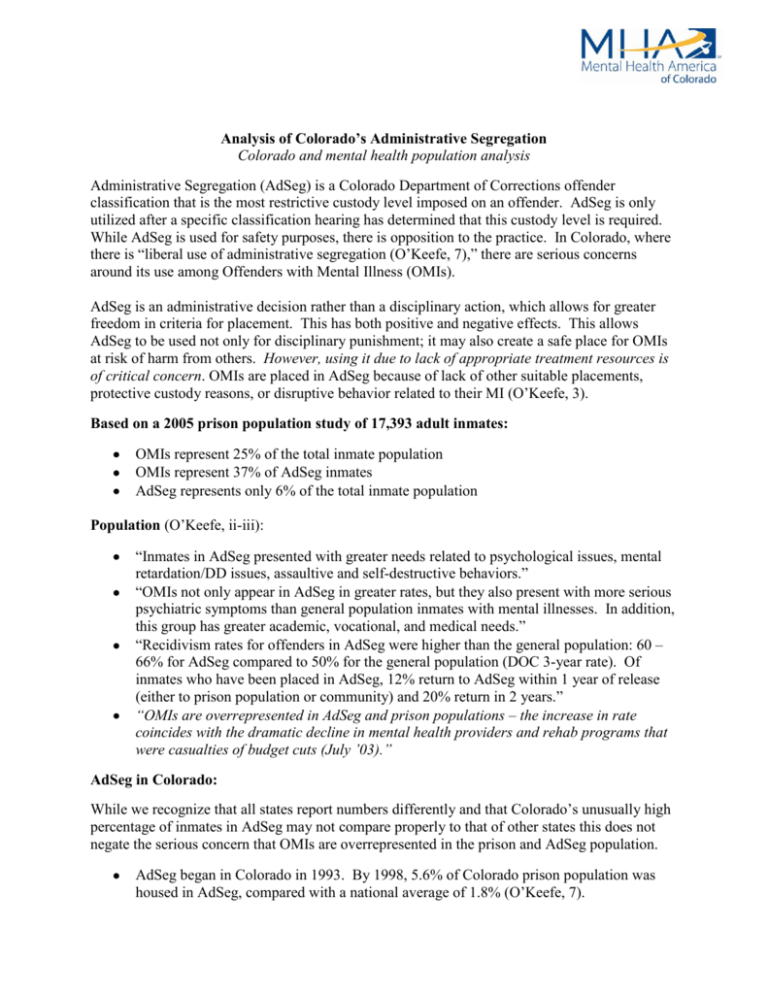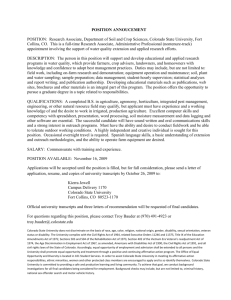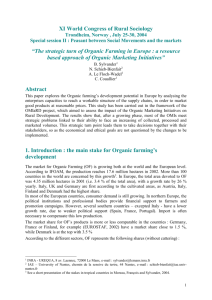Analysis of Colorado's Administrative Segregation Colorado and
advertisement

Analysis of Colorado’s Administrative Segregation Colorado and mental health population analysis Administrative Segregation (AdSeg) is a Colorado Department of Corrections offender classification that is the most restrictive custody level imposed on an offender. AdSeg is only utilized after a specific classification hearing has determined that this custody level is required. While AdSeg is used for safety purposes, there is opposition to the practice. In Colorado, where there is “liberal use of administrative segregation (O’Keefe, 7),” there are serious concerns around its use among Offenders with Mental Illness (OMIs). AdSeg is an administrative decision rather than a disciplinary action, which allows for greater freedom in criteria for placement. This has both positive and negative effects. This allows AdSeg to be used not only for disciplinary punishment; it may also create a safe place for OMIs at risk of harm from others. However, using it due to lack of appropriate treatment resources is of critical concern. OMIs are placed in AdSeg because of lack of other suitable placements, protective custody reasons, or disruptive behavior related to their MI (O’Keefe, 3). Based on a 2005 prison population study of 17,393 adult inmates: OMIs represent 25% of the total inmate population OMIs represent 37% of AdSeg inmates AdSeg represents only 6% of the total inmate population Population (O’Keefe, ii-iii): “Inmates in AdSeg presented with greater needs related to psychological issues, mental retardation/DD issues, assaultive and self-destructive behaviors.” “OMIs not only appear in AdSeg in greater rates, but they also present with more serious psychiatric symptoms than general population inmates with mental illnesses. In addition, this group has greater academic, vocational, and medical needs.” “Recidivism rates for offenders in AdSeg were higher than the general population: 60 – 66% for AdSeg compared to 50% for the general population (DOC 3-year rate). Of inmates who have been placed in AdSeg, 12% return to AdSeg within 1 year of release (either to prison population or community) and 20% return in 2 years.” “OMIs are overrepresented in AdSeg and prison populations – the increase in rate coincides with the dramatic decline in mental health providers and rehab programs that were casualties of budget cuts (July ‟03).” AdSeg in Colorado: While we recognize that all states report numbers differently and that Colorado’s unusually high percentage of inmates in AdSeg may not compare properly to that of other states this does not negate the serious concern that OMIs are overrepresented in the prison and AdSeg population. AdSeg began in Colorado in 1993. By 1998, 5.6% of Colorado prison population was housed in AdSeg, compared with a national average of 1.8% (O’Keefe, 7). From 1995 – 2003: The median length of stay for first time AdSeg offenders was 16.53 months with the maximum at 107 months, which is equal to 8.9 years (O’Keefe, 22). There was a significant spike in the number of OMIs placed in AdSeg after June „03. As the general prison population stayed the same, AdSeg population increased by 4%. DOC points to a dramatic decline in prison mental health professionals and rehab programs due to budget cuts. Analysis AdSeg in Colorado is higher than the national average and it is clear that OMIs are more vulnerable to AdSeg placement. While data demonstrates that the OMI population in Colorado experience shorter durations in AdSeg, OMIs still appear in greater rates than inmates without a mental health diagnosis. DOC points to shortfalls in the state budget and budget cuts for recent increases. What is absolutely clear from this report is that the increase in OMIs in AdSeg is due in large part to budget cuts and reductions in mental health staff and supports. In addition, the end of the report addresses “check-ins” (inmates who, fearing for their safety, engage in minimal behaviors necessary to land them in AdSeg) and suggests that a procedural review of AdSeg decisions could help mitigate this situation. MHAC would like to see a further investigation into the reasons behind OMIs placement in AdSeg. Due to the loose eligibility requirements, reasons for placement are not tracked well. We could have better insight into how and why OMIs are placed in AdSeg at higher rates with better monitoring and stricter guidelines specifically dealing with OMI placement into AdSeg. However, to truly address the overrepresentation of OMIs in AdSeg, Colorado must begin to question and address why OMIs end up in prison in the first place. We know that it costs about $6,000 - $8,000 per year treat a mentally-ill offender in the community, which prevents many nuisance crimes. Incarcerating them costs between $25,000 and $65,818 per year and offers minimal, if any, remedial benefit (Report to the Colorado General Assembly Health Care Task Force). A principal desire of MHAC is to see the issue addressed from a prevention point of view. Better approaches to diversion at the earliest possible stage of entry, new focus on population appropriate programming for those who are not diverted, and a commitment to early identification and treatment in the State will substantially impact this issue. Policy Recommendations Incarceration of the mentally ill rather than increased access and intervention We must begin to address the increase in the OMI population as a symptom of a larger problem. Policies to improve access to care, particularly for the uninsured and underinsured, must be a priority in addressing the OMI overrepresentation in Colorado’s prisons. Policies that seek early intervention and diversion should be supported by the State and reflected in their budget priorities. Organizations such as Metro Crisis Services who works towards providing alternative routes to incarceration need to be reinforced at the State level and seen as a partner in reducing and preventing OMIs in the criminal justice system. Better treatment provisions for OMI‟s Due to the correlation of OMI placement in AdSeg and the decline of mental health providers in prison, one way to reduce OMIs in AdSeg is to ensure better treatment provisions in prison and within AdSeg. Better treatment provisions include, but are not limited to: Increase in safe environment and associated perceptions among OMI – As OMIs are frequently moved to AdSeg as a result of an infraction committed to seek safety through isolation, the creation of an environment where residents are and feel safe is essential. This is also a vital component of effective treatment. Appropriate measures must be taken to ensure staff are trained not only to keep residents safe, but to address appropriately their concerns and perceptions around safety. Parity in treatment – Ensuring parity in treatment in prisons will help reduce OMIs in AdSeg. All mental health conditions and treatment should be treated in an equal manner as physical conditions. This includes equality in number providers per capita for the OMI population, access to treatment and screening, number of visits, medication management, and any other related feature to health. By ensuring parity, mental health crises will be reduced and recovery as a paradigm will be encouraged. Staff training in dealing with the OMI population – As correction facilities become the new institution of need for people with mental health conditions, staff training must be appropriate to the population served. With 25% of incarcerated individuals having a diagnosed mental illness, all staff must be highly competent to address the specific needs of such a population. Indeed, there are instances where staff will escalate a situation rather than deescalate in order to have the OMI moved off the unit. Consumer representation and training – Mental health consumers should have access to and support from mental health consumer organizations such as the Wellness Education Coalition and Advocacy Network (WE CAN) of Colorado to train both staff and consumers in recovery and self advocacy. References O’Keefe, Maureen (2005). Analysis of Colorado‟s Administrative Segregation. Retrieved February 23, 2010 from http://www.doc.state.co.us Report to the Colorado General Assembly Health Care Task Force, December 2008. Colorado Department of Corrections 2007 Statistical Report










